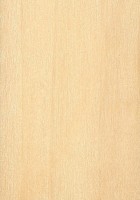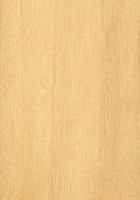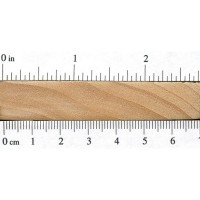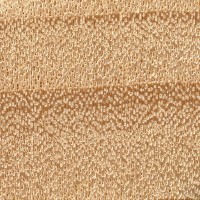 |
Common Name(s): Eastern Cottonwood Scientific Name: Populus deltoides Distribution: Central and eastern United States Tree Size: 100-165 ft (30-50 m) tall, 4-6 ft (1.2-2.0 m) trunk diameter Average Dried Weight: 28 lbs/ft3 (450 kg/m3) Specific Gravity (Basic, 12% MC): .37, .45 Janka Hardness: 430 lbf (1,910 N) Modulus of Rupture: 8,500 lbf/in2 (58.6 MPa) Elastic Modulus: 1,370,000 lbf/in2 (9.45 GPa) Crushing Strength: 4,910 lbf/in2 (33.9 MPa) Shrinkage: Radial: 3.9 %, Tangential: 9.2%, Volumetric: 13.9%, T/R Ratio: 2.4 |
Color/Appearance: Heartwood tends to be a light brown. Sapwood is a pale yellow to nearly white, and isn’t clearly demarcated, tending to gradually blend into the heartwood.
Grain/Texture: Grain is generally straight to slightly irregular or interlocked. Uniform medium texture with low natural luster.
Endgrain: Diffuse-porous; solitary and radial multiples; medium pores in no specific arrangement, moderately numerous to numerous; parenchyma marginal; narrow rays, normal to close spacing.
Rot Resistance: Rated as non-durable, and also susceptible to insect attack.
Workability: Easy to work with hand and machine tools, though sharp cutters are necessary when planing to avoid fuzzy surfaces, (subsequent fine-sanding may be necessary to obtain a smooth surface). Responds poorly to steam bending. Does not split easily, and has poor nail-holding capability. Wood has a tendency to warp and distort during drying. Glues and finishes well.
Odor: Has a sour odor when green, which disappears once the wood is dry.
Allergies/Toxicity: Besides the standard health risks associated with any type of wood dust, no further health reactions have been associated with Eastern Cottonwood. See the articles Wood Allergies and Toxicity and Wood Dust Safety for more information.
Pricing/Availability: Cottonwood is generally regarded as low-value wood, and isn’t commonly harvested or available as lumber—though it can usually be found throughout its natural range for utility purposes. Carving blocks or burl blanks are sometimes available for hobbyist purposes. Prices are low for a domestic hardwood.
Sustainability: This wood species is not listed in the CITES Appendices or on the IUCN Red List of Threatened Species.
Common Uses: Boxes/crates, veneer, plywood, and various utility purposes.
Comments: So named for its cotton-like strands that accompany the tree’s seeds in the spring. Eastern Cottonwood is the state tree of Kansas and Nebraska, and is sometimes called the pioneer of the prairie; pioneers on the Oregon Trail would look for such trees, as their shade and firewood was a welcome respite, and their presence usually meant that water was nearby.








This wood is commonly used in Axe Throwing due to its price, softness, and durability